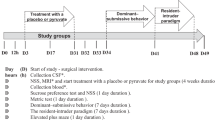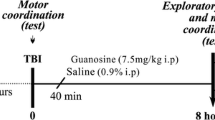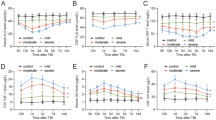Abstract
Excessive glutamate release has been implicated as a major contributor to multiple post-traumatic brain injury (TBI) deficits, including neurodegeneration and cognitive impairment. Prior to the presence of behavior change, synaptic plasticity is rapidly and potently disrupted by TBI, which is believed to be relevant to inappropriately increased extracellular glutamate concentration and glutamatergic receptor activation. Acutely promoting brain glutamate clearance with a blood-based scavenging system, glutamate oxaloacetate transaminase (GOT), prevents the delayed inhibition of LTP post-TBI. Here, we report that repeated dosing of recombinant GOT type 1, with the glutamate co-substrate oxaloacetate, could induce a persistent enhancement of serum level of GOT and reverse the disruption of synaptic plasticity 4 days after the induction of TBI in rats. Moreover, the change of glutamate level post-TBI presents a different timeframe in ventricular CSF and hippocampus interstitial fluid (ISF), and the application of rGOT may reverse the inhibition of LTP by decreasing the glutamate level in hippocampus ISF, but not ventricular CSF. Lastly, we found that the intervention did not significantly affect the total level of glutamate in the hippocampus as well as the expression of major glutamate transporters, EAAT1 and EAAT2. Overall, the present findings support the importance of clearance of glutamate post-TBI and provide new evidence of the mechanism of glutamate-induced LTP inhibition which leads to a development of evaluations, intervention, and reversion for post-TBI cognitive deficit.







Similar content being viewed by others
Abbreviations
- CA1:
-
Cornu ammonis
- CSF:
-
Cerebral spinal fluid
- DMSO:
-
Dimethyl sulfoxide
- fEPSP:
-
Field excitatory post-synaptic potential
- GOT:
-
Glutamate oxaloacetate transaminase
- HFS:
-
High-frequency stimulation
- i.c.v.:
-
Intracerebroventricular
- i.p.:
-
Intraperitoneal
- ISF:
-
Interstitial fluid
- LTD:
-
Long-term depression
- LTP:
-
Long-term potentiation
- mGlu:
-
Metabotropic glutamate
- NMDA:
-
N-methyl-d-aspartate
- OXA:
-
Oxaloacetate
- s.c.:
-
Subcutaneous
- SEM:
-
Standard error of the mean
- TBI:
-
Traumatic brain injury
References
Baker AJ, Moulton RJ, MacMillan VH, Shedden PM (1993) Excitatory amino acids in cerebrospinal fluid following traumatic brain injury in humans. J Neurosurg 79:369–372
Bernstein DM (2002) Information processing difficulty long after self-reported concussion. J Int Neuropsychol Soc 8:673–682
Boyko M, Stepensky D, Gruenbaum BF, Gruenbaum SE, Melamed I, Ohayon S, Glazer M, Shapira Y, Zlotnik A (2012) Pharmacokinetics of glutamate-oxaloacetate transaminase and glutamate-pyruvate transaminase and their blood glutamate-lowering activity in naive rats. Neurochem Res 37:2198–2205
Brotfain E, Kutz R, Grinshpun J, Gruenbaum BF, Gruenbaum SE, Frenkel A, Zhumadilov A, Zeldetz V, Bichovsky Y, Boyko M, Klein M, Zlotnik A (2018) Blood glutamate reducing effect of hemofiltration in critically ill patients. Neurotox Res 33:300–308
Campos F, Sobrino T, Ramos-Cabrer P, Argibay B, Agulla J, Perez-Mato M, Rodriguez-Gonzalez R, Brea D et al (2011) Neuroprotection by glutamate oxaloacetate transaminase in ischemic stroke: an experimental study. J Cereb Blood Flow Metab 31:1378–1386
Cantu D, Walker K, Andresen L, Taylor-Weiner A, Hampton D, Tesco G, Dulla CG (2015) Traumatic brain injury increases cortical glutamate network activity by compromising GABAergic control. Cereb Cortex 25:2306–2320
Castillo J, Loza MI, Mirelman D, Brea J, Blanco M, Sobrino T, Campos F (2016) A novel mechanism of neuroprotection: blood glutamate grabber. J Cereb Blood Flow Metab 36:292–301
Danbolt NC (2001) Glutamate uptake. Prog Neurobiol 65:1–105
Goldshmit Y, Jona G, Schmukler E, Solomon S, Pinkas-Kramarski R, Ruban A (2018) Blood glutamate scavenger as a novel neuroprotective treatment in spinal cord injury. J Neurotrauma
Hausser N, Johnson K, Parsley MA, Guptarak J, Spratt H, Sell SL (2018), Detecting behavioral deficits in rats after traumatic brain injury. J Vis Exp
Hu N-W, Nicoll AJ, Zhang D, Mably AJ, O’Malley T, Purro SA, Terry C, Collinge J, Walsh DM, Rowan MJ (2014) mGlu5 receptors and cellular prion protein mediate amyloid-β-facilitated synaptic long-term depression in vivo. Nat Commun 5:3374
Kalia LV, Kalia SK, Salter MW (2008) NMDA receptors in clinical neurology: excitatory times ahead. Lancet Neurol 7:742–755
Koola MM (2018) Galantamine-memantine combination for cognitive impairments due to electroconvulsive therapy, traumatic brain injury, and neurologic and psychiatric disorders: kynurenic acid and mismatch negativity target engagement. Prim Care Companion CNS Disord 20
Lakshmanan R, Loo JA, Drake T, Leblanc J, Ytterberg AJ, McArthur DL, Etchepare M, Vespa PM (2010) Metabolic crisis after traumatic brain injury is associated with a novel microdialysis proteome. Neurocrit Care 12:324–336
Lee A, Anderson AR, Rayfield AJ, Stevens MG, Poronnik P, Meabon JS, Cook DG, Pow DV (2012) Localisation of novel forms of glutamate transporters and the cystine-glutamate antiporter in the choroid plexus: implications for CSF glutamate homeostasis. J Chem Neuroanat 43:64–75
Liraz-Zaltsman S, Slusher B, Atrakchi-Baranes D, Rosenblatt K, Friedman Levi Y, Kesner E, Silva AJ, Biegon A, Shohami E (2018) Enhancement of brain d-serine mediates recovery of cognitive function after traumatic brain injury. In: J Neurotrauma, vol 35, pp 1667–1680
Muir KW (2006) Glutamate-based therapeutic approaches: clinical trials with NMDA antagonists. Curr Opin Pharmacol 6:53–60
Nagy D, Marosi M, Kis Z, Farkas T, Rakos G, Vecsei L, Teichberg VI, Toldi J (2009) Oxaloacetate decreases the infarct size and attenuates the reduction in evoked responses after photothrombotic focal ischemia in the rat cortex. Cell Mol Neurobiol 29:827–835
Nakada T, Kwee IL (2018) Fluid dynamics inside the brain barrier: current concept of interstitial flow, glymphatic flow, and cerebrospinal fluid circulation in the brain. Neuroscientist:1073858418775027
Narayan RK, Michel ME, Ansell B, Baethmann A, Biegon A, Bracken MB, Bullock MR, Choi SC, Clifton GL, Contant CF, Coplin WM, Dietrich WD, Ghajar J, Grady SM, Grossman RG, Hall ED, Heetderks W, Hovda DA, Jallo J, Katz RL, Knoller N, Kochanek PM, Maas AI, Majde J, Marion DW, Marmarou A, Marshall LF, McIntosh TK, Miller E, Mohberg N, Muizelaar JP, Pitts LH, Quinn P, Riesenfeld G, Robertson CS, Strauss KI, Teasdale G, Temkin N, Tuma R, Wade C, Walker MD, Weinrich M, Whyte J, Wilberger J, Young AB, Yurkewicz L (2002) Clinical trials in head injury. J Neurotrauma 19:503–557
O’Kane RL, Martinez-Lopez I, DeJoseph MR, Vina JR, Hawkins RA (1999) Na(+)-dependent glutamate transporters (EAAT1, EAAT2, and EAAT3) of the blood-brain barrier. A mechanism for glutamate removal. J Biol Chem 274:31891–31895
Park Y, Luo T, Zhang F, Liu C, Bramlett HM, Dietrich WD, Hu B (2013) Downregulation of Src-kinase and glutamate-receptor phosphorylation after traumatic brain injury. J Cereb Blood Flow Metab 33:1642–1649
Perez-Mato M, Ramos-Cabrer P, Sobrino T, Blanco M, Ruban A, Mirelman D, Menendez P, Castillo J et al (2014) Human recombinant glutamate oxaloacetate transaminase 1 (GOT1) supplemented with oxaloacetate induces a protective effect after cerebral ischemia. Cell Death Dis 5:e992
Piao CS, Holloway AL, Hong-Routson S, Wainwright MS (2017) Depression following traumatic brain injury in mice is associated with down-regulation of hippocampal astrocyte glutamate transporters by thrombin. J Cereb Blood Flow Metab 271678x17742792
Ruban A, Cohen-Kashi Malina K, Cooper I, Graubardt N, Babakin L, Jona G, Teichberg VI (2015) Combined treatment of an amyotrophic lateral sclerosis rat model with recombinant GOT1 and oxaloacetic acid: a novel neuroprotective treatment. Neurodegener Dis 15:233–242
Silva-Candal Ad, Vieites-Prado A, Gutierrez-Fernandez M, Rey RI, Argibay B, Mirelman D, Sobrino T, Rodriguez-Frutos B et al (2015) Blood glutamate grabbing does not reduce the hematoma in an intracerebral hemorrhage model but it is a safe excitotoxic treatment modality. J Cereb Blood Flow Metab
Singh K, Trivedi R, Verma A, D'Souza M M, Koundal S, Rana P, Baishya B, Khushu S (2017) Altered metabolites of the rat hippocampus after mild and moderate traumatic brain injury - a combined in vivo and in vitro (1) H-MRS study. NMR Biomed 30
Vagnozzi R, Tavazzi B, Signoretti S, Amorini AM, Belli A, Cimatti M, Delfini R, Di Pietro V et al (2007) Temporal window of metabolic brain vulnerability to concussions: mitochondrial-related impairment--part I. Neurosurgery 61:379–388 discussion 388-379
Villmann C, Becker CM (2007) On the hypes and falls in neuroprotection: targeting the NMDA receptor. Neuroscientist 13:594–615
Virk S, Williams T, Brunsdon R, Suh F, Morrow A (2015) Cognitive remediation of attention deficits following acquired brain injury: a systematic review and meta-analysis. NeuroRehabilitation 36:367–377
Wang CC, Wee HY, Hu CY, Chio CC, Kuo JR (2018) The effects of memantine on glutamic receptor-associated nitrosative stress in a traumatic brain injury rat model. World Neurosurg 112:e719–e731
Witgen BM, Lifshitz J, Smith ML, Schwarzbach E, Liang SL, Grady MS, Cohen AS (2005) Regional hippocampal alteration associated with cognitive deficit following experimental brain injury: a systems, network and cellular evaluation. Neuroscience 133:1–15
Xu S, Zhuo J, Racz J, Shi D, Roys S, Fiskum G, Gullapalli R (2011) Early microstructural and metabolic changes following controlled cortical impact injury in rat: a magnetic resonance imaging and spectroscopy study. J Neurotrauma 28:2091–2102
Zhang H, Zhang X, Zhang T, Chen L (2001) Excitatory amino acids in cerebrospinal fluid of patients with acute head injuries. Clin Chem 47:1458–1462
Zhang D, Mably AJ, Walsh DM, Rowan MJ (2016) Peripheral interventions enhancing brain glutamate homeostasis relieve amyloid beta- and TNFalpha- mediated synaptic plasticity disruption in the rat hippocampus. Cereb Cortex 27:3724–3735
Zhang D, Qi Y, Klyubin I, Ondrejcak T, Sarell CJ, Cuello AC, Collinge J, Rowan MJ (2017) Targeting glutamatergic and cellular prion protein mechanisms of amyloid β-mediated persistent synaptic plasticity disruption: longitudinal studies. Neuropharmacology 121:231–246
Funding
This study was supported by the National Natural Science Foundation of China (no. 81701085), Henan Key Laboratory of Neural Regeneration and Repairment (no. HNSJXF-2018-020), China Postdoctoral Science Foundation (no. 2017M620833 and no. 2018T110121), and Beijing Postdoctoral Research Foundation (no. 2017-zz-121).
Author information
Authors and Affiliations
Contributions
D.Z. performed experiments, interpreted data, and drafted the manuscript. M.X. and L.W. performed experiments. W.J. designed and supervised this study and edited the manuscript.
Corresponding author
Ethics declarations
The animal care and experimental protocol were performed according to the guidelines of the Guidance for Animal Experimentation of the Capital Medical University, and the protocol was approved by the Experimental Animal Ethics Committee of the Beijing Tiantan Hospital, Capital Medical University.
Rights and permissions
About this article
Cite this article
Zhang, D., Xiao, M., Wang, L. et al. Blood-Based Glutamate Scavengers Reverse Traumatic Brain Injury-Induced Synaptic Plasticity Disruption by Decreasing Glutamate Level in Hippocampus Interstitial Fluid, but Not Cerebral Spinal Fluid, In Vivo. Neurotox Res 35, 360–372 (2019). https://doi.org/10.1007/s12640-018-9961-8
Received:
Revised:
Accepted:
Published:
Issue Date:
DOI: https://doi.org/10.1007/s12640-018-9961-8




